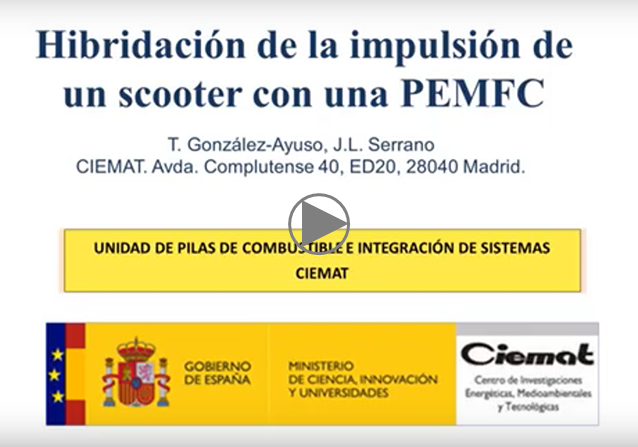Actividades del Grupo de Integración de Sistemas
El grupo de Integración de Sistemas trabaja en el desarrollo de aplicaciones de pilas de combustible y en la integración de pilas de combustible en sistemas integrados para la generación de energía eléctrica. Está compuesto por un investigador (doctor), dos ingenieros y personal auxiliar y en formación. Los proyectos desarrollados se relacionan tanto con aplicaciones estacionarias, como el desarrollo de un procesador de combustible con una pila de combustible integrada, como aplicadas al transporte, integración de una pila de combustible en pequeños vehículos, o portátiles, desarrollo de un sistema de alimentación ininterrumpida con pila de combustible. Para más información (contactar).
TrigeneraciÓn con GEoTermia, Hidrógeno y Energías Renovables (TOGETHER)
 TrigeneraciÓn con GEoTermia, Hidrógeno y Energías Renovables
TrigeneraciÓn con GEoTermia, Hidrógeno y Energías Renovables
Convocatoria: Retos-Colaboración 2017 del Programa Estatal de Investigación, Desarrollo e Innovación Orientada a los Retos de la Sociedad, en el marco del Plan Estatal de Investigación Científica y Técnica y de Innovación 2013-2016.
Organismo Financiador: Ministerio de Ciencia, Innovación y Universidades y cofinanciado por la Unión Europea a través del Fondo Europeo de Desarrollo Regional (FEDER)
Número de expediente: RTC-2017-5926-3.
Palabras claves: cogeneración, micro-CHP, eficiencia energética, geotermia, hidrógeno, electrolizador
Objetivo del Proyecto: Mejorar la eficiencia energética en la climatización, generación de ACS y suministro eléctrico mediante el desarrollo tecnológico y de investigación de un sistema versátil y modular que incluya los campos de generación de energía, almacenamiento, y uso, basada en la combinación de EE.RR. y del ciclo del hidrógeno en sistemas de cogeneración de calor y frío con geotermia y máquinas de absorción. Los desarrollos del proyecto se estudiarán en dos laboratorios con diferentes condiciones de trabajo (componentes del sistema y modos de operación) y el sistema global en un living-lab, bajo condiciones reales de uso. A su vez se desarrollarán sistemas para la utilización directa del hidrógeno generado en los equipos destinados a la generación de ACS, calefacción y refrigeración con el objetivo de mejorar de sus rendimientos. Se harán trabajos de aprovechamiento de los equipos de microcogeneración como son las pilas de combustible de uso estacionario, de tal manera que se puedan optimizar la cogeneración de electricidad y calor de diferentes potencias y su validación en aplicaciones reales, de forma que se puedan identificar los nichos de mercado de la tecnología y sirva de plataforma de lanzamiento para la introducción de esta tecnología en el mercado.
Duración: 2018-2020
Entidades participantes: Geothermal Energy, S.L. (coordinador), DESIGENIA, H2B2 Electrolysis Technologies, CIEMAT y CNH2.
Participantes del CIEMAT: Unidad de Eficiencia Energética en la Edificación y Unidad de Pilas de Combustible e Integración de Sistemas


Estación de generación autónoma (EGA1500)
En la Unidad se dispone de un laboratorio de ensayos en el que se han integrado diferentes equipos con el objetivo de comprobar su funcionamiento en distintas condiciones de operación y estudiar su comportamiento cuando se opera en un sistema integrado.
En el laboratorio se desarrollan secuencias de control de los distintos equipos para minimizar el consumo de energía.
El laboratorio de ensayos permite una relativamente fácil integración de cualquier equipo y el estudio de su comportamiento como parte del sistema integrado.
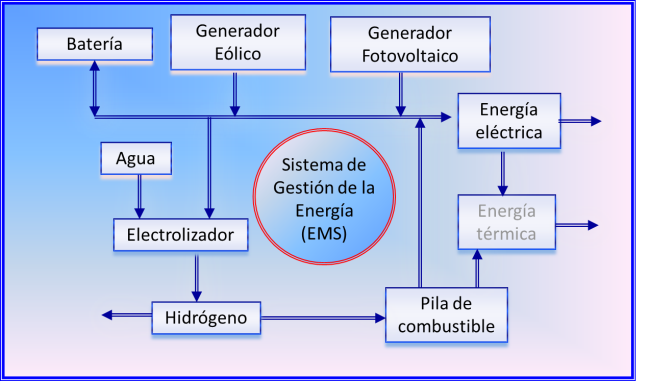
Esquema de Laboratorio de Ensayos
Integración de electrolizadores
Se ha adquirido un electrolizador Claind de 1 Nm3/h de capacidad de producción de hidrógeno a una presión máxima de 15 bar.
Se ha instalado y se ha conectado al sistema de almacenamiento de hidrógeno (SAH) de la estación de demostración de generación autónoma (EGA) con la que cuenta el Ciemat. El SAH permite almacenar el hidrógeno sobre hidruros metálicos permitiendo operar el sistema y generar la energía necesaria.
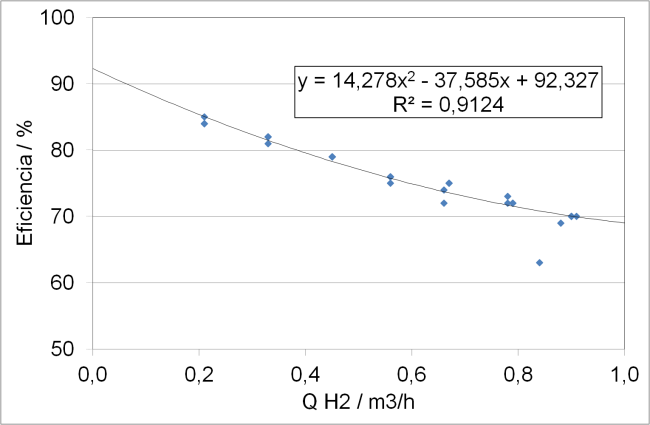
Variación de la eficiencia del electrolizador con la producción de hidrógeno
Simulación
Se ha simulado la operación del sistema integrado en función de diferentes perfiles, tanto de los generadores de energía (paneles fotovoltaicos y turbinas eólicas) como de la carga (perfiles simulados de consumo).
La dimensión y características de los diferentes equipos pueden ser modificadas para realizar la simulación con parámetros de cualquier equipo.

Resultado de la simulación con fuente eólica predominante
UPS mejorada mediante la incorporación de una PEMFC
La utilización de pilas de combustible como generadores principales en sistemas de alimentación ininterrumpida permite disminuir considerablemente el peso y aumentar el tiempo de funcionamiento.
Los elementos básicos que integran el sistema son una pila de combustible polimérica, hidrógeno almacenado en hidruros metálicos, una pequeña batería y un inversor de corriente.
La pila de combustible utilizada es de tipo PEM, con una potencia nominal de 500 W Como combustible utiliza hidrógeno, y como comburente, aire.
El aire es alimentado mediante una turbina eléctrica impulsada por la batería, y el hidrógeno procede de las botellas de hidruros metálicos integradas en el sistema. Se ha integrado también una batería para la alimentación del sistema en los transitorios.
El equipo incluye un inversor final que reconvierte la salida en corriente continua de la batería y pila de combustible a corriente alterna, y se completa con la instrumentación adecuada para monitorizar los parámetros de control.
El sistema desarrollado se ha denominado UPS-FC05. Un aspecto del mismo puede visualizarse en la Fig. 1. En su acabado se han incluido los indicadores para visualizar los datos de voltaje y corriente, tanto en corriente continua como en corriente alterna, y los de las presiones de hidrógeno en las botellas de hidruros y en la pila de combustible.
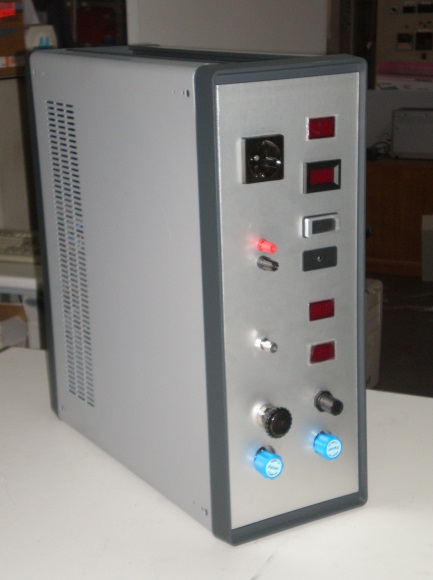
Sistema auxiliar de potencia UPS-FC05
Generación eléctrica mediante integración de procesador y pila de combustible (PACO)
Diseño y construcción de plantas de reformado de biogás y acondicionamiento del combustible para su alimentación a una PEMFC. El procesado de combustible consta de una etapa de reformado seco, seguida de una de water-gas shift y por último de oxidación preferente de CO. El aporte de calor al proceso proviene de un quemador alimentado con los gases de salida anódicos de la pila y una porción variable del biogás de entrada. Un análisis de las potencias caloríficas en juego muestra cómo la principal disipación de calor proviene del diseño del circuito de tuberías, mientras que el proceso energéticamente más importante es la evaporación de H2O necesaria para la reacción de water-gas shift.
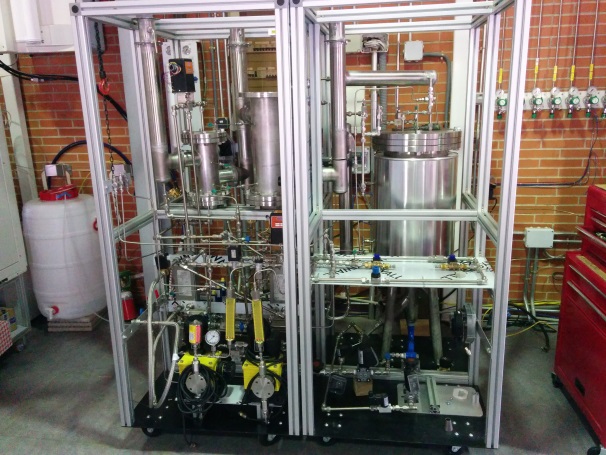
Procesador DIVERCEL
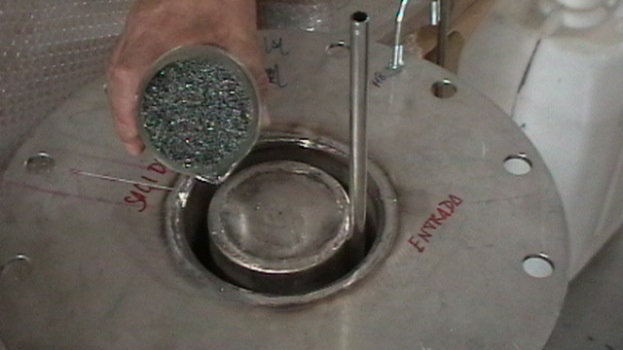
Aporte del catalizador de reformado
Integración de una PEMFC en pequeños vehículos
Se está estudiando la hibridación de la alimentación eléctrica de dos vehículos con una PEMFC. Se ha estudiado el comportamiento del motor en distintos ciclos de conducción y las distintas formas de integración de la PEMFC con las baterías. Posteriormente se están integrando sendas pilas de combustible y su sistema de alimentación basado en varias botellas para almacenamiento de hidrógeno en forma de hidruro metálico. La salida eléctrica de las pilas de combustible se acondiciona para la alimentación de los motores mediante los correspondientes convertidores CC/CC que adecúan las tensiones de las pilas de combustible a la requerida por los motores.
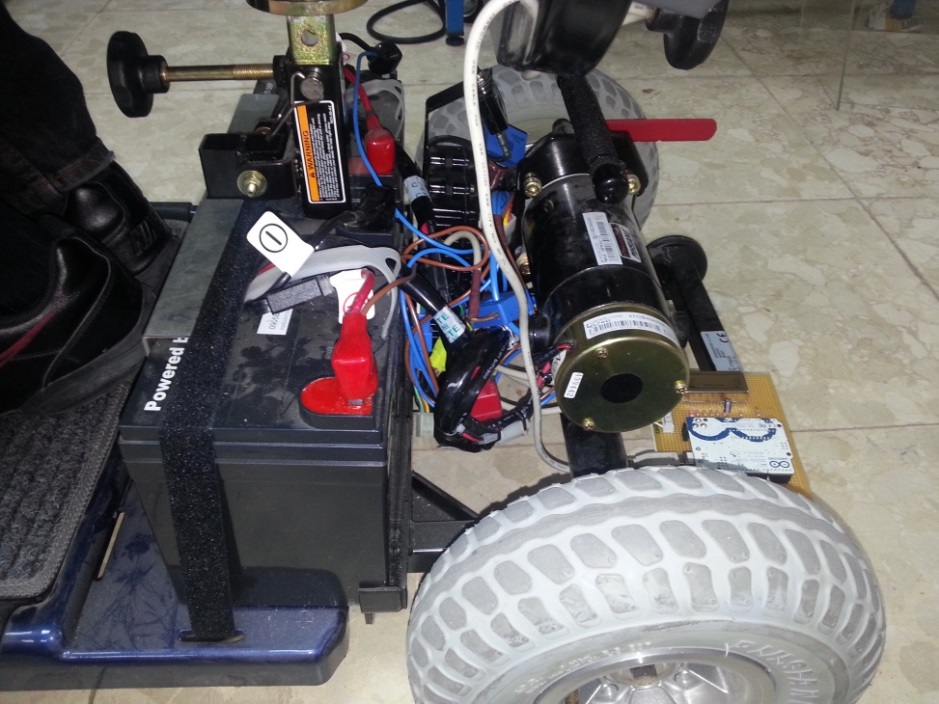
Scooter eléctrico PIHSIANG
Se ha integrado, en una silla de ruedas eléctrica, una pila de combustible y su sistema de alimentación basado en botellas de hidruros metálicos para el almacenamiento del hidrógeno. La salida eléctrica de la pila de combustible se acondiciona para la alimentación de los motores mediante un convertidor CC/CC que adecúa la tensión de la pila de combustible a la requerida por los motores. El calor generado por la pila de combustible se aprovecha reconduciéndolo hacia las botellas de almacenamiento para así facilitar la desorción del hidrógeno del hidruro metálico. Además se ha implementado un sistema de control y monitorización de las variables del sistema a través de una pantalla táctil con la que podemos interactuar para conectar o desconectar la pila de combustible, ver el estado de los elementos del sistema y la autonomía restante.
Referencias
Generación de hidrógeno a partir de fuentes de energía renovables. T. González-Ayuso, M. Labrador, M.A. Folgado, J.L. Serrano, L. Daza. CONAPPICE2006. 237-240, Octubre 2006.
GELSHI: Un sistema híbrido de generación de energía. T. González-Ayuso, M. Labrador, M.A. Folgado, J.L. Serrano, L. Daza. CONAPPICE2006, 301-304, Octubre 2006.
Hydrogen management in APU hydrid system with fuel cell. T. González-Ayuso; M.A. Folgado; J.L. Serrano; J.L. Ortiz; A.M. Chaparro; L. Daza. WS-21: Hydrogen as a future energy carrier. Ávila, Spain, 2007.
Influence of the operation conditions on hydrogen production by electrolysis. T. González-Ayuso; M.A. Folgado; J.L. Serrano; A.M. Chaparro; L. Daza. WS-21: Hydrogen as a future energy carrier. Ávila, Spain, 2007.
Sistema autónomo de energía con pila de combustible. T. González-Ayuso, J.L. Serrano, F. Chenlo, J.L. Ortiz, L. Daza. CONAPPICE2008. ISBN 978-84-691-4415-2. 369-372. Septiembre 2008.
Unidad de potencia auxiliar (UPS) basada en pila de combustible. T. González-Ayuso, J.L. Serrano, J.L. Ortiz, M. Lambea, L. Daza. CONAPPICE2008. ISBN 978-84-691-4415-2. 399-402. Septiembre 2008.
Sistema para generación ininterrumpida de energía, basado en conversión fotovoltaica y pila de combustible. T. González-Ayuso; J.L. Serrano; A.M. Chaparro; M.A: Folgado; J.L. Ortiz; L. Daza. I Congreso de Generación Distribuida, GENEDIS 2009. Madrid, 2009
Development of the Energy Management System to control a Hybrid power generator. J.L. Serrano; T. González-Ayuso; A.M. Chaparro; J.L. Ortiz; L. Daza. 2009 Fuel Cell Seminar. Palm Springs, 2009.
Autonomous integrated system with solar energy and fuel cell. T. González-Ayuso; J.L. Serrano; A.M. Chaparro; J.L. Ortiz; L. Daza. 2009 Fuel Cell Seminar. Palm Springs, 2009.
Auxiliar power unit with increased auntonomy by means of a fuel cell system. T. González-Ayuso; J.L. Serrano; A.M. Chaparro; J.L. Ortiz; L. Daza. 2009 Fuel Cell Seminar, Palm Springs, 2009.
Operación de una PEMFC con gas de reformado. T. González-Ayuso; J. Pérez; M.A. Folgado; L. Daza. CONAPPICE 2010. Sevilla, España. 2010
Optimización de las condiciones de presión en una pila de combustible de membrana polimérica. B. Martínez Ruiz; J.L. Serrano; T. González Ayuso; L. Daza. CONAPPICE 2010, Sevilla, España, 2010.
Estrategias de control ante demanda variable de potencia para una planta de procesado de biogás acoplada a una pila de combustible polimérica. A.J. Martín; T. González Ayuso; M.A. Folgado; F. Daza; G. Muñoz; L. Daza. CONAPPICE 2010. Sevilla, España. 2010.
Diseño térmicamente eficiente mediante simulación de un sistema real de procesado de biogás acoplado a una pila de combustible de baja temperatura. A.J. Martín; T. González Ayuso; M.A. Folgado; F. Daza; G. Muñoz; L. Daza. CONAPPICE 2010. Sevilla, España. 2010.
Condiciones de llenado y vaciado de botellas de hidruros metálicos para la alimentación de una pila de combustible polimérica. J.L. Ortiz; J. Pérez; T. González Ayuso; L. Daza. CONAPPICE 2010. Sevilla, España. 2010.
Integration of a PEMFC in a UPS. J.L. Ortiz; F. Daza; T. González-Ayuso; L. Daza. 4th Edition of the European Fuel Cell Technology & Applications Piero Lunghi Conference. Roma, Italia. 2011.
Operation of biogas processing plant for electrical energy generation basen on dry reforming and low temperatura fuel cells. A.J. Martín; T. González-Ayuso; L. Daza. 4th edition of the European Fuel Cell Technology & Applications Piero Lunghi Conference. Roma, Italia. 2011.
Thermal analysis of a fuel cell by infrared thermography. J.A. Daza; A.J. Martín; A.M. Chaparro; T. González-Ayuso; L. Daza. 4th edition of the European Fuel Cell Technology & Applications Piero Lunghi Conference. Roma, Italia. 2011.
Influence of some critical operation parameters on the performance of a 5 m3-h-1 biogas processing plant for electricity generation based on dry reforming and low temperature fuel cells. A.J. Martín; T. González-Ayuso; L. Daza. 4th edition of the European Fuel Cell Technology & Applications Piero Lunghi Conference. Roma, Italia. 2011.
Analysis of a biogas processing plant coupling with a low temperature fuel cell. A.J. Martin; G. Muñoz; M.A. Folgado; J. Mielgo; L. Daza; T. González-Ayuso. 2011 Fuel Cell Seminar. Orlando, 2011.
Hybrid system based on fuel cell and hydrogen technology. B. Martínez Ruiz; T. González-Ayuso; L. Daza. 4th edition of the European Fuel Cell Technology & Applications Piero Lunghi Conference. Roma, Italia. 2011.
Operación de un procesador novedoso de biogás basado en reformado seco para producción de energía eléctrica mediante pilas de combustible. A.J. Martín; T. González Ayuso; J.L. Serrando; J. Mielgo; L. Daza. XXIII Congreso Iberoamericano de Catálisis. Santa Fe, Argentina. 2012.
Análisis de una microrred con generación de origen renovable e integración con pila de combustible de tipo PEM. B. Martínez Ruiz; J.L. Serrano; T. González-Ayuso; L. Daza. CONAPPICE 2012. Madrid, 2012.
Influencia de la composición del combustible en la operación de una PEMFC. T. González-Ayuso; F. Daza; L. Daza. CONAPPICE 2012. Madrid, 2012.
Operación de un procesador de combustible. T. González; A.J. Martín; J.L. Serrano; L. Daza. CONAPPICE 2012. Madrid, 2012.
Results analysis of a microgrid composed by photovoltaic generators and fuel cell. B. Martínez Ruiz, J.L. Serrano, T. González-Ayuso. European Fuel Cell - Piero Lunghi Conference & Exhibition 2013. Roma, diciembre 2013.
A multi-fuel processor test bench based on reforming coupled to a fuel cell as a previous stage to industrial scale-up. A.J. Martín; T. González-Ayuso; C. Montoro; J.L. Serrano; J.A. Daza; A. Balbín; L. Daza. European Hydrogen Enegy Conference - EHEC 2014. Sevilla, España. 2014.
Control de operación de un electrolizador en un sistema integrado. T. González-Ayuso, J.L. Serrano, N. Santos. Congreso Iberoamericano de Hidrógeno y Pilas de Combustible Iberconappice 2014. Barcelona 2014.
Hibridación de la impulsión de un scooter con una PEMFC. T. González-Ayuso, J.L. Serrano, L. Fernández Beites, D. Rodríguez. Congreso Iberoamericano de Hidrógeno y Pilas de Combustible Iberconappice 2014. Barcelona 2014.
Simulación de la integración de una PEMFC en una vivienda. T. González-Ayuso, S. Soutullo. Congreso Iberoamericano de Hidrógeno y Pilas de Combustible Iberconappice 2014. Barcelona 2014.
La termografía infrarroja cuantitativa como herramienta para estimación de temperaturas en sistemas complejos. J.A. Daza, M. Tejada, T. González Ayuso, L. Daza. Congreso Iberoamericano de Hidrógeno y Pilas de Combustible Iberconappice 2014. Barcelona 2014.
Documentación relacionada
A continuación se listan los informes y otros documentos existentes, de acceso restringido, relacionados con la investigación (ver documentación):

